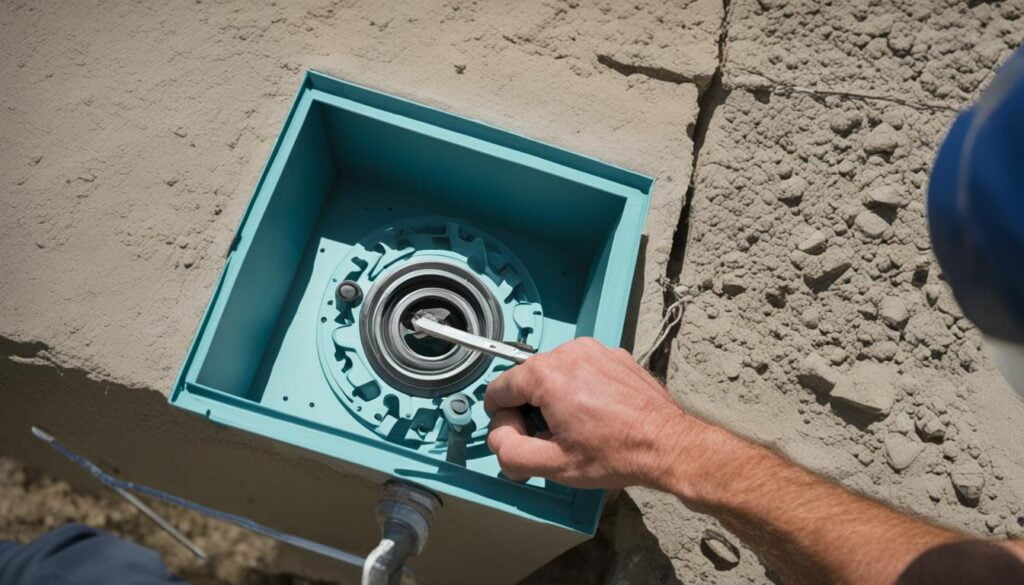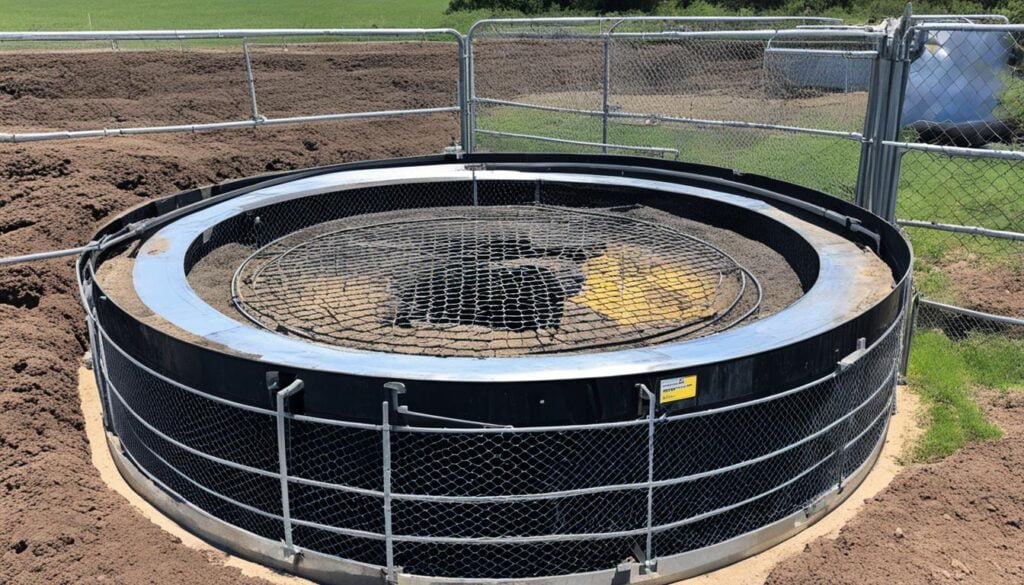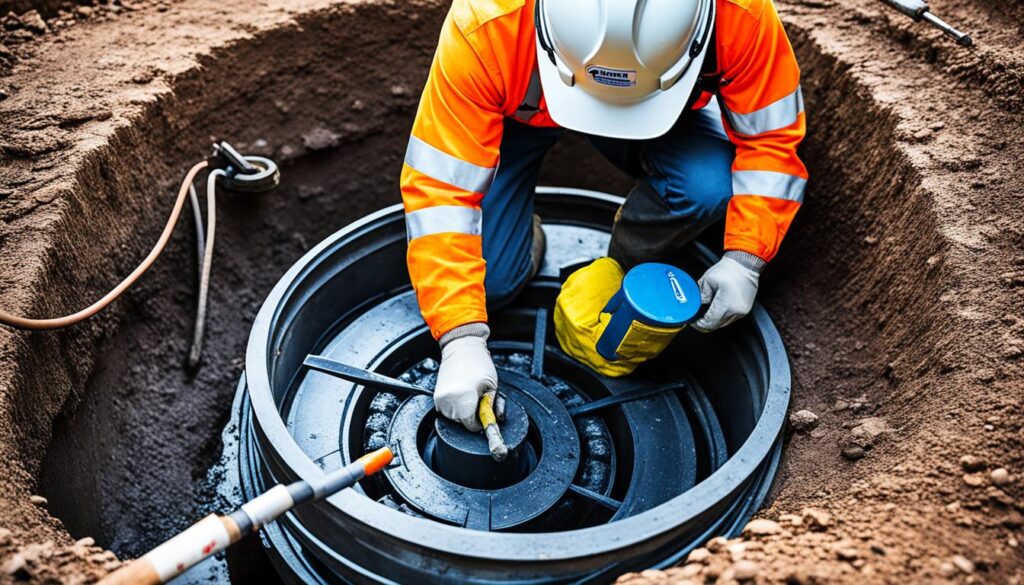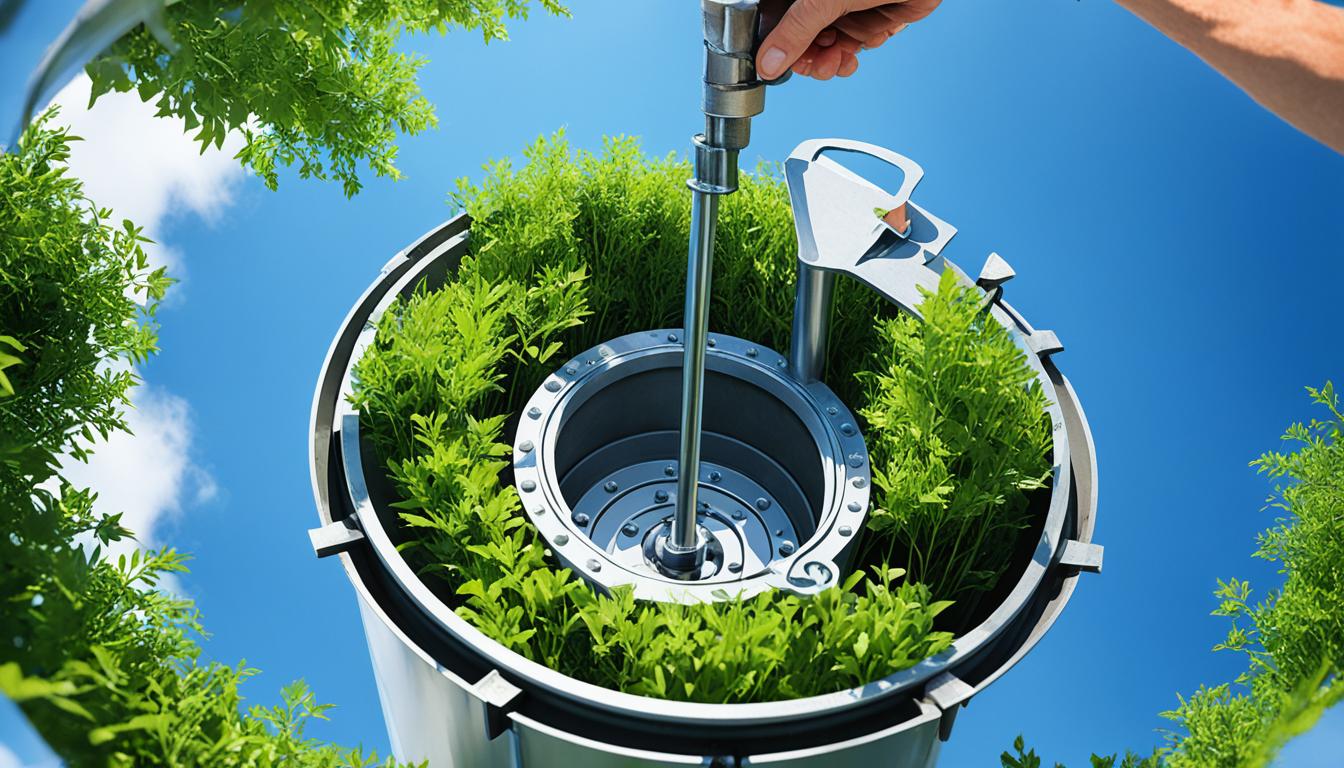This post contains affiliate links.
Did you know that contaminated well water can pose serious health risks, affecting not only you and your family but also your entire community? According to studies, around 15% of Americans rely on private wells for their water supply, exposing them to potential contamination from septic tanks, pesticides, and household chemicals.
Ensuring well cap safety is crucial in preventing the infiltration of contaminants into your well. By following essential well cap safety tips, you can protect your well and safeguard the quality of your water. From proper well location and construction to regular maintenance and testing, each step plays a vital role in maintaining well cap safety.
Key Takeaways:
- Contaminated well water can pose serious health risks to individuals and communities.
- Around 15% of Americans rely on private wells for their water supply.
- Proper well cap safety measures are essential to prevent contamination.
- Well location, construction, maintenance, and testing are crucial for ensuring well cap safety.
- Following well cap safety tips will help protect the quality of your well water.
Proper Well Location for Well Cap Safety
When it comes to ensuring well cap safety, selecting the right location for your well is of utmost importance. By following well cap inspection guidelines and adhering to well cap standards, you can safeguard your well from potential contaminants. Here are essential factors to consider for proper well location:
- Elevation: It is recommended to position your well high in the landscape to promote effective drainage of surface water. This reduces the risk of water pooling around your well cap, preventing potential contamination.
- Contaminant Sources: It is crucial to situate your well uphill from potential sources of contamination, such as septic tanks and pesticide storage facilities. This ensures that any contaminants are naturally directed away from your well.
- Separation Distances: The Georgia Water Well Standards Act of 1985 stipulates minimum separation distances that must be maintained between your well and various sources of contamination. This prevents pollutants from reaching your well. Here are a few examples:
- At least 50 feet from septic tanks
- At least 100 feet from petroleum storage tanks
- At least 200 feet from hazardous waste storage areas
Well Location Best Practices
“Choosing the right location for your well is the first step toward ensuring well cap safety. By considering elevation, avoiding potential contaminant sources, and following separation distance guidelines, you can protect your well from harmful pollutants.”
| Contaminant | Minimum Separation Distance |
|---|---|
| Septic Tanks | At least 50 feet |
| Petroleum Storage Tanks | At least 100 feet |
| Hazardous Waste Storage Areas | At least 200 feet |
Proper Well Construction for Well Cap Safety
A properly constructed and sealed well is crucial for maintaining well cap safety. The construction of the well needs to adhere to the regulations and requirements outlined in the Georgia Water Well Standards Act of 1985. By following these guidelines, you can ensure the integrity of your well cap and protect your water supply from potential contamination.
Well Casing Extension
When constructing a well, the casing should extend above the surrounding ground level. This is essential to prevent surface water, such as rainwater or runoff, from seeping into the well. By keeping the well casing above ground, you minimize the risk of contaminants entering the well through the cap.

Tight-Fitting Well Cap
The top of the well casing must be fitted with a tight-fitting well cap. This cap should be vermin-proof, preventing insects, rodents, and other small animals from accessing the well. Additionally, the well cap should have a screened vent to allow for adequate ventilation while keeping out debris and contaminants.
Annular Space Sealing
The annular space around the well casing needs to be properly sealed with grouting. This seal prevents the flow of water and pollutants down into the well. By sealing the annular space, you create a barrier that protects the water supply and ensures the safety of your well cap.
“A properly constructed well is like a safeguard for your water supply. By following the regulations and guidelines set forth by the Georgia Water Well Standards Act of 1985, you can have peace of mind knowing that your well cap is secure and your water is safe.”
Proper construction techniques and adherence to well cap regulations are essential for maintaining a safe and reliable water supply. By ensuring that your well is constructed correctly, with an extended casing, a tight-fitting well cap, and a sealed annular space, you minimize the risk of contamination and ensure well cap safety for years to come.
| Benefits of Proper Well Construction |
|---|
| Protects the water supply from contamination |
| Prevents the entry of surface water into the well |
| Minimizes the risk of vermin infestation |
| Ensures compliance with well cap regulations |
Keeping Contaminants Away from Your Well
Preventing contamination is crucial for well cap safety. By following simple guidelines and taking necessary precautions, you can ensure the protection of your wellhead and the safety of your water supply. Here are some essential steps you can take:
Avoid Storing Chemicals in Your Wellhouse
Chemicals stored near your well can potentially contaminate the groundwater. Keep pesticides, fertilizers, and other household chemicals in dedicated storage areas away from your wellhouse.
Proper Disposal of Household Chemicals and Medications
Take care when disposing of household chemicals and medications to prevent them from entering your well. Never pour them down the drain or toilet, as they can seep into the groundwater. Instead, follow proper disposal procedures recommended by your local waste management authorities.
Do Not Dispose of Motor Oil on the Ground
Motor oil is hazardous and should never be disposed of on the ground or in storm drains. It can contaminate the surrounding soil and potentially reach the groundwater. Always dispose of motor oil responsibly at designated recycling centers.
Prevent Backflow to Avoid Contamination
Backflow occurs when untreated water flows back into the water system, potentially contaminating your well. To prevent backflow, install backflow prevention devices, such as backflow valves or air gaps, on outdoor faucets and sprinkler systems. These devices ensure that contaminated water cannot flow back into your well.
Seal and Fill Abandoned Wells
Abandoned wells are a significant source of contamination and pose safety risks. If you have any abandoned wells on your property, it is crucial to seal and properly fill them. This prevents pollutants from entering the groundwater and eliminates potential hazards. Consult with a licensed water well driller to carry out the sealing process according to the guidelines provided by the Georgia Water Well Standards Act of 1985.
| Common Contaminants | Effects on Well Water | Prevention Methods |
|---|---|---|
| Pesticides and Herbicides | Health risks, taste, and odor issues | Proper storage, correct application, regular testing |
| Septic Tank Effluents | Bacterial contamination, foul smell | Proper distance, regular inspection, maintenance |
| Chemical Spills | Potential health hazards, water discoloration | Safe handling, prompt cleanup, reporting incidents |
By following these practices, you can significantly reduce the risk of contaminating your well and protect your wellhead. Taking the necessary precautions will ensure the safety and quality of your drinking water.

Testing Well Water for Well Cap Safety
Regular testing of well water is essential for ensuring well cap safety and the quality of your drinking water. It is crucial to conduct routine testing for bacteria and nitrates, as these contaminants can have harmful effects on your health. However, it is also important to be aware of other potential contaminants that may be present in your well water.
Developing a long-term record of water testing can help you identify any changes in water quality over time and take necessary actions to protect your well cap safety.
Common Contaminants and Testing
While testing for bacteria and nitrates should be done regularly, there are other contaminants that can also be present in well water. Some common contaminants include:
- Heavy metals (e.g., lead, arsenic)
- Chemicals (e.g., pesticides, fertilizers)
- Volatile organic compounds (e.g., gasoline, solvents)
- Radioactive substances (e.g., radon)
It is recommended to conduct additional testing for these contaminants if there are reasons to suspect their presence. For a comprehensive evaluation of well water quality, consider testing for a wider range of parameters, such as pH, hardness, alkalinity, and total dissolved solids.
The Importance of Water Testing
Regular water testing provides valuable insights into the quality and safety of your well water. It helps ensure that your well cap remains intact and that your drinking water is free from harmful contaminants. By testing your well water, you can:
- Identify any potential issues with your well cap or wellhead
- Detect the presence of harmful contaminants early
- Take appropriate measures to ensure the safety of your water supply
- Monitor any changes in water quality over time
By regularly testing your well water, you can protect the integrity of your well cap and maintain the well cap safety required for a clean, healthy water supply.
Importance of Wellhead Protection for Well Cap Safety
Wellhead protection is paramount when it comes to safeguarding your water supply from potential contaminants. Ensuring proper installation of a sanitary well cap equipped with a rubber gasket and screen is of utmost importance. These components act as a barrier against pollutants, keeping your well cap secure and your water clean.
Furthermore, it is essential to pay attention to the grading of the land around the wellhead. Proper grading ensures that surface water flows away from the well, reducing the risk of contamination. By maintaining a well-drained area, you can minimize the potential for pollutants to seep into the groundwater.
Installing anti-backflow devices on outdoor faucets is another effective measure for wellhead protection. These devices prevent the reverse flow of contaminated water, safeguarding your water supply from potential contamination.
To enhance well cap safety, it is recommended to establish a designated wellhead protection area. This area should be free from potential sources of contamination, such as septic systems, chemical storage facilities, and animal waste. By keeping these potential contaminants at a safe distance, you can significantly reduce the risk of wellhead contamination.
Now that you understand the importance of wellhead protection, let’s take a look at a comprehensive table outlining the key components and practices for ensuring well cap safety:

Key Components and Practices for Well Cap Safety
| Components | Practices |
|---|---|
| Sanitary well cap with rubber gasket and screen | Ensure proper installation and regular maintenance |
| Proper grading of land around the wellhead | Ensure water flows away from the well |
| Anti-backflow devices | Install on outdoor faucets to prevent contaminated water from flowing back into the water supply |
| Wellhead protection area | Establish and keep free from potential contaminants |
By implementing these measures for wellhead protection, you can maintain the integrity of your well cap, protect your water supply, and ensure the well-being of yourself and your community.
Sealing Abandoned Wells for Well Cap Safety
Abandoned wells are a significant concern when it comes to well cap safety. These wells can potentially become a source of contamination and pose safety hazards. To mitigate these risks, it is crucial to properly seal and plug abandoned wells. This preventive measure helps prevent pollution and accidents, safeguarding the integrity of your water supply.
The Georgia Water Well Standards Act of 1985 provides guidelines for the sealing of abandoned wells. To ensure the process is carried out correctly and adheres to the regulations, it is essential to engage the services of a licensed water well driller. Their expertise and knowledge will guarantee that the sealing process is done effectively and in compliance with the industry standards.
To give you a clearer understanding of the importance of sealing abandoned wells, let’s take a look at the following table:
| Benefits of Sealing Abandoned Wells | Consequences of Unsealed Abandoned Wells |
|---|---|
|
|
Sealing abandoned wells is crucial for maintaining well cap safety and protecting both human health and the environment. By following the guidelines set forth by the Georgia Water Well Standards Act of 1985 and involving a licensed water well driller, you can ensure that abandoned wells are sealed properly and no longer pose a threat.

Backflow Prevention for Well Cap Safety
Backflow can pose a major risk to the safety of your well cap and water supply. Contaminated fluids flowing back into the groundwater can lead to serious health hazards. To prevent backflow and ensure wellhead protection, it’s crucial to install appropriate backflow preventers. There are two commonly used types: double check valves and atmospheric vacuum breakers.
Double check valves are reliable devices that prevent back siphonage. They consist of two independently acting check valves and a test cock. These valves create a barrier between the water supply and the potential source of contamination. Atmospheric vacuum breakers, on the other hand, use atmospheric pressure to prevent backflow. When a drop in pressure occurs, the valve opens to release air, preventing the backward flow of water.
Additionally, taking basic precautions can further help in preventing backflow. It’s important to never submerge a hose into potential contaminating material, as this can introduce pollutants into the water system. Always keep your hoses elevated or use a hose bib vacuum breaker to ensure wellhead safety.
To summarize:
- Install either double check valves or atmospheric vacuum breakers to prevent backflow.
- Never submerge a hose into potential contaminating material.
- Elevate hoses or use hose bib vacuum breakers to maintain wellhead protection.
By implementing these backflow prevention measures, you can safeguard your well cap and ensure the continued safety of your water supply.
Importance of Routine Maintenance for Well Cap Safety
Routine maintenance plays a vital role in ensuring the ongoing safety and integrity of your well cap. Conducting regular inspections of the well cap, casing, and grouting is essential to identify any issues or signs of deterioration that could compromise the safety of your well. By keeping up with maintenance activities, you can address potential problems early on and prevent more significant issues from arising.
Regular inspections should be carried out to assess the condition of the well cap, ensuring it remains in compliance with well cap standards. Inspections should also encompass the casing to check for any leaks or damages that could lead to contamination. Additionally, inspecting the grouting will help ensure that it is intact and effectively sealing the annular space around the casing, preventing the intrusion of water and pollutants.
Keep a detailed record of all maintenance activities, including inspection dates, findings, and any necessary repairs or replacements. This record will provide a comprehensive picture of the well’s condition over time and help you track any recurring issues. It will also serve as documentation for compliance with well cap standards and regulations.
In addition to regular inspections, it’s important to conduct routine water quality testing for your well. This testing will help identify any changes or abnormalities in the water that could indicate a problem with the well cap or potential contamination. Keep records of these test results alongside your maintenance activities for a complete overview of your well’s health.
By prioritizing routine maintenance, you ensure the ongoing safety and reliability of your well cap. Taking proactive measures to address any issues and stay in compliance with well cap standards will help safeguard the quality of your water supply and protect the health of your family and community.
| Benefits of Routine Maintenance for Well Cap Safety |
|---|
| Ensures ongoing well cap safety |
| Identifies and addresses issues early on |
| Maintains compliance with well cap standards |
| Prevents contamination and water quality issues |
| Protects the health of your family and community |
Conclusion
Ensuring the safety of your well cap is crucial for maintaining the quality of your well water. By following essential well cap safety tips, such as selecting the proper well location, constructing and maintaining the well cap correctly, and preventing contamination, you can safeguard your wells and protect your water supply.
Compliance with well cap standards and regulations is essential to secure your operations and guarantee the well-being of your family and community. Regularly testing your well water for contaminants, such as bacteria and nitrates, will help identify any changes in water quality over time, enabling prompt action if necessary.
Remember, wellhead protection is the first line of defense against potential contaminants. Installing a sanitary well cap with a tight-fitting rubber gasket and screen, along with adequate grading of the land around the wellhead, is crucial. Additionally, sealing and properly filling abandoned wells prevent pollution and accidents.
By prioritizing well cap safety, you can have peace of mind knowing that you are taking essential steps to protect your well water and ensure a safe and healthy water supply for years to come.
FAQ
What is the key to maintaining well cap safety?
The key to maintaining well cap safety is selecting a proper location for your well, ensuring proper construction, and preventing contamination.
What should I consider when selecting a location for my well?
When selecting a location for your well, consider siting it uphill from potential sources of contamination, such as septic tanks and pesticide storage facilities. Also, ensure that the location is high in the landscape to allow surface water to drain away.
How should a well be constructed for well cap safety?
A properly constructed well should have a well casing that extends above the surrounding ground, a tight-fitting well cap with a screened vent, and sealed annular space around the casing to prevent water and pollutants from entering.
How can I prevent contamination of my well?
To prevent contamination, avoid storing chemicals in your wellhouse, dispose of household chemicals and medications properly, and never dispose of motor oil on the ground. It’s also important to take steps to prevent backflow and properly seal and fill abandoned wells.
How often should well water be tested for well cap safety?
Well water should be routinely tested for bacteria and nitrates, with additional testing for other contaminants as needed. Developing a long-term record of water testing helps identify any changes in water quality over time.
How does wellhead protection enhance well cap safety?
Wellhead protection, which includes the installation of a sanitary well cap with a rubber gasket and screen, proper grading around the wellhead, and the establishment of a wellhead protection area, helps prevent contaminants from entering the water supply.
How should abandoned wells be sealed for well cap safety?
Abandoned wells should be sealed and plugged according to the guidelines provided in the Georgia Water Well Standards Act of 1985. It’s important to have a licensed water well driller carry out the process.
How can backflow be prevented to ensure well cap safety?
Backflow can be prevented by installing backflow preventers, such as double check valves and atmospheric vacuum breakers, and by taking precautions like not submerging a hose into potential contaminating material.
How often should routine maintenance be performed for well cap safety?
Regular inspections of the well cap, casing, and grouting should be conducted to identify any issues or signs of deterioration. Routine maintenance activities should be recorded to help maintain ongoing well cap safety.
Source Links
- https://extension.usu.edu/waterquality/homeownerswater/wellhead-protection
- https://extension.uga.edu/publications/detail.html?number=C858-1&title=protecting-your-well-and-wellhead
- https://extension.psu.edu/protecting-your-water-well
This post contains affiliate links.

